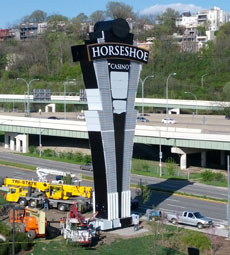Much is written about the fabrication and installation of signs, but how about what happens in between—the shipping and transportation of those signs to the install site?
AFP Global Logistics in Hanover, Maryland, a family- and women-owned business started in 1991 that specializes in all things shipping, handles this side of the sign business. They started servicing signage shipments about fifteen years ago, and since then, it’s become 35 percent of their business—and they constantly bring on additional customers thanks to word of mouth and customer referrals.
“In the Baltimore area, where our actual headquarters are located,” says Brandi Whitecotton, vice president of Sales at AFP Global Logistics, “there are numerous, large sign manufacturers that have the need for partnering up with their installation teams on the other end, setting up deliveries, debris removal, etc. There’s a lot of them here in our market that needed the special white glove type of service.”
Just what does that white glove service involve? The answer: Everything from setting up delivery appointments (including at special times, like at night) to debris removal at delivery sites to communicating with customers about modes of transportation. AFP even helps the post office handle its shipments.
But no matter who a sign shop decides to work with for its shipping needs, Whitecotton says there are some things they should keep in mind.
Communication
Keeping the lines of communication open between the client, the installer, and any other involved parties is huge, and a shop should ensure they’re working with a company that can manage all of that.
Clear communication upfront also helps prevent problems down the line since the shipping company or sign shop can ensure the installer is ready for a package and has all the equipment they need to handle an incoming shipment.
Insurance
Shops spend a lot of time, effort, and money on fabricating signs, so it’s important to insure them if they need to be shipped to an installation site. Damages during shipping can be costly and take up time, which can push a project timeline back.
“If you’re getting ready to put a sign up and you’ve got a scratch on the paint and have to bring somebody on site to fix that, the cost of that is expensive, and you want to get that money back,” says Whitecotton. “We’re all about finding the value of the product and determining whether we should insure it on our end to protect our client or encourage them to do rider policies on their own to insure their product.”
Packaging
Insufficient packaging can even affect insurance claims.
“When sign companies cut corners and don’t enclose crates for finished signs, they’re leaving a lot of risk for damages,” says Whitecotton. “Even if a company were to purchase insurance on a damaged shipment, and it wasn’t packaged correctly, our insurance company would deny the claim due to improper packaging.”
AFP aims educate their clients on proper packaging.
For those they frequently work with, they get to know their freight and can point out weaknesses or vulnerable spots in the packaging of previous shipments where they might want to beef it up on current packages. For new clients, they typically have them send a picture of the sign they’re shipping and the dimensions so they can give recommendations.
In specific instances where a more custom touch is needed, AFP turns to its partner package companies. These partners are all over and can even be dispatched to a customer’s location to work one-on-one with them. AFP also has relationships with special crating teams that can custom build crates, when needed.
AFP even offers options for shops that don’t want to package a sign or that have a sign that proves difficult to package. AFP can instead deliver the sign to the site on a twenty-four-foot straight truck. “We like to give our clients options,” says Whitecotton.
AFP offers up some basic pointers to keep in mind for packing signs:
- Design your packaging for both the contents and the means of transport. For example, if the sign will be shipped by air freight or any other type of shipping that requires additional handling, then over-packing should be done.
- Reduce the risk of theft during shipping by making sure no one can identify the contents of your package. Use a plain carton or black stretch wrap with non-descript markings.
Modes of Transportation
Just as packaging is important, how a sign is shipped matters too.
Air freight is ideal for packages with strict time schedules, but shops should be aware that dimensions like size and weight can restrict signs from air freight. “If they’re not approved by the TSA as an actual business, then the TSA can reject us from moving anything on an aircraft, as well,” says Whitecotton.
As far as shipping by truck, shops have two options: FTL (full truckload) and LTL (less than truckload).
FTL shipping means a shop has enough product to fill an entire truck or they need a dedicated truck to handle a delicate/high-risk sign. FTL is faster than LTL shipping and ideal for high-risk shipments since the packaging remains in one truck with minimal handling. However it’s more expensive.
LTL shipping offers shops a more cost-effective option when their shipments aren’t high-risk and don’t require the full space of a truck. The shipment price is based on the travel distance, overall weight, and type of freight.
LTL shipping also typically offers guaranteed, on-time delivery to keep your project on track. Shops should be sure to sufficiently and carefully package signs since they will be handled more and travel with other packages.
On the Receiving End
Naturally sign shops are concerned about getting signs packaged and seeing them off via the best shipping method, but they should also consider the receiver on the other end.
“A lot of these smaller sign companies we deliver to are residences, and we have to be careful what type of vehicle we use,” says Cathy Moon, president of AFP Global Logistics. “You can’t send in a big, fifty-three-foot trailer when they can only accommodate a box truck that’s maybe twenty-four feet.”
It’s also important to make sure smaller shops or businesses are able to handle your sign shipment, especially if it’s extremely heavy or large. The client receiving the package may need special equipment on their end to handle it.
Overall shops should focus on the details of shipping as much as they do fabrication or installation to ensure their signs get from point A to point B safely.
By Ashley Bray
All Photos: AFP Global Logisitics; Signage by Gable











